Automated Storage: How to grow operations?...Make them smaller
Five case studies highlight how operations both big and small improved density, throughput and customer satisfaction with automated storage solutions.
Whether business-to-business, business-to-consumer or both, few companies have seamlessly adapted to the e-commerce boom. The exponential increase in the need for speed and accuracy have prompted many to toss out decades-old habits and assumptions about warehousing and distribution operations.
Automated storage, once a luxury only for the deepest of pockets, has emerged as an ideal solution for those struggling to cope with SKU proliferation and strained storage systems. The following case studies illustrate how businesses of all sizes have benefited from these solutions.
These companies were approaching, or were at, the breaking point and considered dramatic moves like building new or expanded facilities or adding shifts. Some had already dismissed automation out of hand, assuming it was too expensive or complex for their business. Desperate for alternatives, each company was pleasantly surprised by the answers from solution providers.
The introduction of automated storage challenged another assumption: that one size fits all. As order profiles shifted, it became clear to these companies that different storage and picking methodologies suited different segments of their SKU population. By defining and targeting each segment, they were able to deploy the technology in a way that played to the technology’s strengths and was best suited to the businesses’ objectives.
Warehouse automation freshens accuracy and speed
Robotic gantry replaces strenuous manual materials handling in less space.
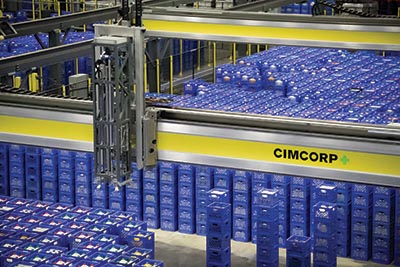 When Kroger began planning to build its first new fluid milk plant in more than 20 years, the company sought a state-of-the-art facility. The ideal solution would require minimal human involvement to minimize injury and work-related strain, but it also had to meet the requirements of Kroger’s zero-waste-to-landfill initiative. The new turnkey robotic gantry-based order fulfillment system (Cimcorp Group) helped the company improve accuracy, product traceability and turnaround times.
When Kroger began planning to build its first new fluid milk plant in more than 20 years, the company sought a state-of-the-art facility. The ideal solution would require minimal human involvement to minimize injury and work-related strain, but it also had to meet the requirements of Kroger’s zero-waste-to-landfill initiative. The new turnkey robotic gantry-based order fulfillment system (Cimcorp Group) helped the company improve accuracy, product traceability and turnaround times.
Located in Denver, the facility opened in 2014 and now services about 160 stores in two states. The 215,000-square-foot facility processes conventional and organic milk in half-gallon and gallon containers, and packages aseptically processed milk, creams and juices in quart-sized and smaller bottles. The facility is centered around a fully automated, robotic production storage, handling and order processing system. The system can store up to 36,000 crates and is able to pick 32,000 crates per day with 100% accuracy.
The solution includes a warehouse management system (WMS), robotic gantries, software modules and an inter-platform communications system. Instead of installing a traditional in-floor mounted ‘drag-chain’ style conveyor, the system handles stacks or single plastic dairy cases on knee-high plastic belt conveyors. The cases and/or stacks are picked according to Kroger’s specified sequence on one end of the facility and then palletized for truck loading onto delivery trucks at the other end of the facility, allowing for significant storage buffering in between.
The solution precisely controls the entire material flow of the facility and offers flexible use of space, easy cleaning and improved labor savings. The end-to-end solution also allows for the automatic collection of data for detailed analysis of dispatch operations and production planning. The company received recognition for its innovative facility design and was named Dairy Foods 2015 Plant of the Year.
Vertical lift modules help manufacturer clean up inventory
Consolidating two warehouses into one reduces storage space by 58%, increases capacity and increases productivity by 33%.
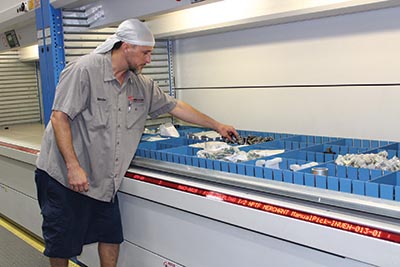 Vac-Con is a leading manufacturer of industrial trucks for sewer and drain cleaning, employing more than 300 people at its headquarters in Green Cove Springs, Fla. Serving public and private sectors, Vac-Con has manufactured more than 7,777 custom-built trucks since 1986. It takes on average 4,000 parts to manufacture one custom truck. After combining two warehouse locations into a single new facility designed for vertical storage, the company was able to bring its inventory under one roof.
Vac-Con is a leading manufacturer of industrial trucks for sewer and drain cleaning, employing more than 300 people at its headquarters in Green Cove Springs, Fla. Serving public and private sectors, Vac-Con has manufactured more than 7,777 custom-built trucks since 1986. It takes on average 4,000 parts to manufacture one custom truck. After combining two warehouse locations into a single new facility designed for vertical storage, the company was able to bring its inventory under one roof.
Vac-Con usually begins one to two new truck builds per day—which means pulling 8,000 parts per day from inventory. With thousands of stock keeping units in inventory, Vac-Con was using one warehouse to store purchased parts and another for manufactured parts, in a combined total of 71,000 square feet. Parts would travel separately to manufacturing to be matched up for production. The space and cost required to manage these two separate inventories and transport them to manufacturing was draining efficiencies.
With the current manufacturing facility at capacity and a new building design under way, the company seized the opportunity to consolidate parts inventory into one 29,200-square-foot warehouse—a 58% footprint reduction. The new facility features six 40-foot vertical lift modules (VLMs) integrated with inventory management software, pick-to-light technology and a 12-position batch station. The new automated storage system (Kardex Remstar) also increased overall storage capacity.
“The VLMs enabled us to bring all of the inventory parts into one, central location,” says Ian Beattie, inventory control manager. “To maximize density, we went to the ceiling with the VLMs to use less floor space.”
Prior to installing the VLMs, Vac-Con was restricted in the amount of trucks they could produce. They have now eliminated time spent walking around multiple warehouses tracking down parts. In the previous system, operators also needed to bend down to pick parts stored low or use ladders to reach the higher items. Parts stored within the VLMs are now brought directly to the operator at an ergonomic height, which has further increased productivity.
“We are a manufacturing facility and the goal is to get the right part to the correct place at the correct time,” says Beattie, who highlights a boost in inventory accuracy. “The increased security of having the parts inside the machine with limited access has been an added benefit for us.”
VLM helps postpone warehouse relocation
Automated storage cuts storage space by 85% while improving productivity and accuracy.
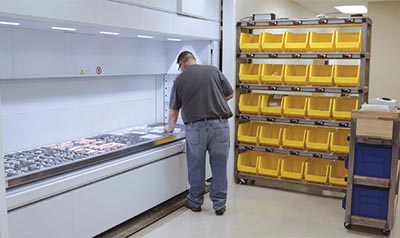 Industrial Automation Supply (IAS), located in Portland, Maine, is an electrical controls and automation components distributor with a focus on serving the original equipment manufacturers market in New England. They store a wide variety of electrical products, ranging from power supplies to terminal blocks. As Industrial Automation Supply’s business continues to grow, it became apparent they were running out of warehouse space. A new vertical lift module (VLM) helped the company postpone relocation while increasing productivity.
Industrial Automation Supply (IAS), located in Portland, Maine, is an electrical controls and automation components distributor with a focus on serving the original equipment manufacturers market in New England. They store a wide variety of electrical products, ranging from power supplies to terminal blocks. As Industrial Automation Supply’s business continues to grow, it became apparent they were running out of warehouse space. A new vertical lift module (VLM) helped the company postpone relocation while increasing productivity.
Prior to purchasing a VLM unit (Modula), workers had to walk around the warehouse area picking a single order at a time. This posed a challenge because much of the product that is stored and handled is received in the morning and often has to be shipped out to clients the same day. From the outset, IAS put a lot of thought into how they would optimize the shipping and receiving processes to make them as efficient as possible.
The new VLM solution produced significant space savings, housing in 98 square feet more than 85% of its 1,500 products, which were previously stored on shelving. Operators report the unit has a very short learning curve and is user-friendly. Another major benefit is increased productivity and picking accuracy. Picking time has been cut in half, which has freed up time to work on other tasks. Using a put-to-light system has also enabled batch picking. Each time the VLM presents a tray, all parts required for multiple orders can be picked at a single time. They are also able to batch pick orders from a single picking location, further increasing throughput and worker efficiency as they no longer have to walk and search for needed items.
Automated storage helps consolidate warehouses
Saving 90,000 square feet, new robotic goods-to-person solution supports 20,000 picks per day.
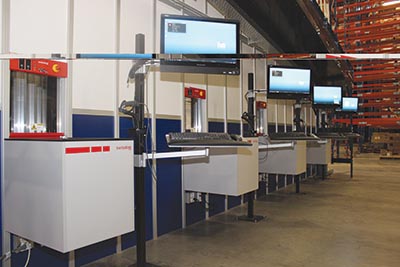 Pro’s Choice Beauty Care is a distributor of professional hair care products. Until recently, the company didn’t believe it could justify warehouse automation.
Pro’s Choice Beauty Care is a distributor of professional hair care products. Until recently, the company didn’t believe it could justify warehouse automation.
“We were continually analyzing the economics of manual versus automated processes and didn’t feel there was a strong enough economic case to move to automation,” says Marc Garrett, CIO of Pro’s Choice. “But the technology matured quickly in the last several years and, as the cost of labor continued to rise while the investment required to automate came down, the economic case became too strong to ignore. In 2016, we felt the time was right to move to an automated goods-to-person fulfillment strategy.”
The company’s new robotic goods-to-person system (Swisslog) was designed for small-order and small-case-pick SKUs. The solution consists of a three-dimensional grid of self-supporting bins that are moved to pick stations by the independently operating robots. The robots are centrally controlled by complex proprietary software that optimizes the sequencing of bin deliveries and routing on the grid.
“We didn’t want to do automation just because it was the next big thing,” Garrett says. “It had to make sense for our business, and this does.”
The implementation at Pro’s Choice’s warehouse features high-density storage of 21,000 bins with 85 robots to support the company’s requirements of 20,000 picks per day.
“It has offered outstanding storage density and we took advantage of that to consolidate two warehouse locations into one, reducing our total square footage by 90,000 square feet,” Garrett says. “We also liked the fact that the system is designed with no single point of failure. If there is ever an issue with one robot, it doesn’t impact our ability to fulfill orders.”
Automation supports global manufacturer’s growth plans
Shuttle-based storage system saves company from costly expansions to a struggling warehouse.
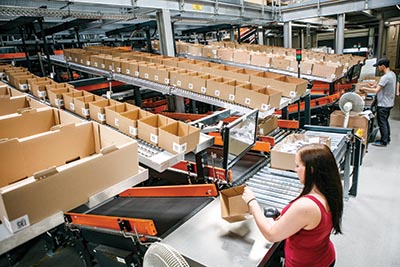 Founded in the city of Essen in Germany in 1969, ifm GmbH develops, produces and sells sensors, controllers and systems for industrial automation worldwide. To date, it has produced around 17 million products with more than 650 patents, 70 of which were granted in 2015 alone. Facing rapid growth, the company moved into a new global distribution center. Built around a shuttle-based automated storage and retrieval system (AS/RS), the new facility increased throughput while preventing the company from having to add a second shift.
Founded in the city of Essen in Germany in 1969, ifm GmbH develops, produces and sells sensors, controllers and systems for industrial automation worldwide. To date, it has produced around 17 million products with more than 650 patents, 70 of which were granted in 2015 alone. Facing rapid growth, the company moved into a new global distribution center. Built around a shuttle-based automated storage and retrieval system (AS/RS), the new facility increased throughput while preventing the company from having to add a second shift.
In its old warehouse, order processing was predominantly manual, with warehouse staff working from pick lists and RF terminals among shelves and flow racks. Picking errors and low operator performance were common. Combined with limited storage locations, the setup was not capable of handling the company’s growth.
“The average order has been the same over the past year: two line items, and between one and 10 pieces. If we want to develop our turnover, then we need to increase the number of packages we send out,” says ifm’s managing director Thorben Petersen. “We spend approximately 8% of our turnover on R&D, which means new products are introduced all the time. We want to guarantee customers can order them as soon as they are available, but this means having the space for storage locations.”
The company’s new 67,000-square-foot distribution center supplies the company’s distribution network in more than 70 countries. The new system (Vanderlande) comprises a 10-aisle racking structure, an integrated shuttle track system, 25 multidirectional shuttles and seven lifts that allow the shuttles to move between rack levels and system exits/entries.
The system provides easy access to 8,000 products in 23,320 locations. Because each shuttle can reach every location, service levels are kept at a maximum. Maintenance platforms with additional staircases also allow quick operator access for troubleshooting. The system is also supported by the supplier’s spare parts plan and maintenance hotline.
“We preferred a ‘hybrid’ system, which combines goods-to-person and person-to-goods technologies,” Petersen says. “The shuttles are an excellent solution for moving goods to the operator, but for faster moving items, we chose a pick-to-light system. It’s a perfect match for the flexibility and scalability we need.”
Upon receipt, operators scan goods into the system and deposit them into single- or four-SKU cartons on trays. A shuttle then carries trays to available locations within the racking. For picking, trays are delivered to one of two destinations. Fast-movers, the top 250 products, are delivered as replenishment for the flow racks directly connected to the shuttle system. Slow-movers head to the goods-to-person workstations.
Currently capable of handling 800 shipping cartons per hour, the system can be expanded across four additional aisles if demand increases.
“This is a vital step forward for the company that will allow us the capacity for future growth” Petersen says. “I feel proud to be part of this transition and part of the team that is responsible for it.”













